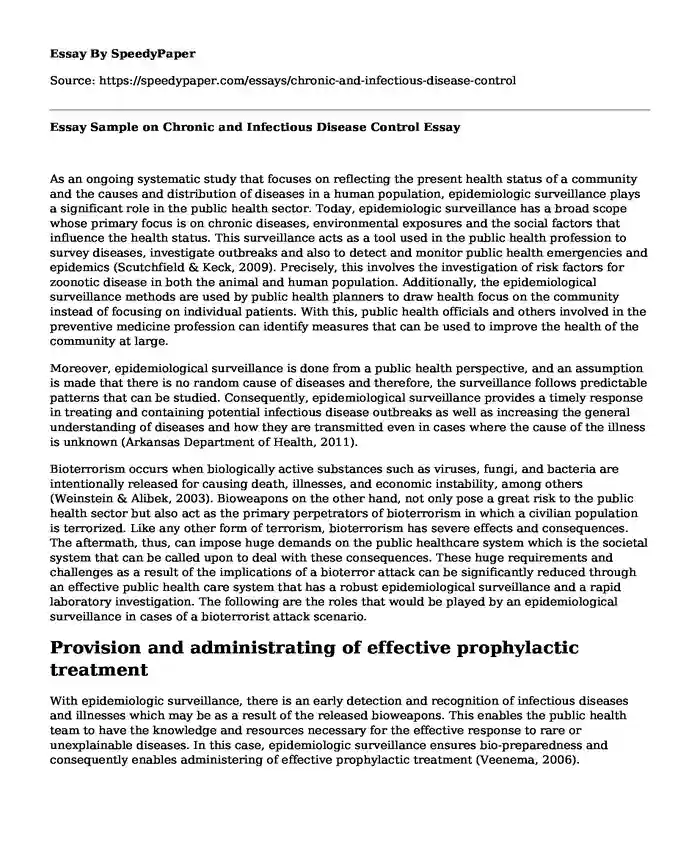
| Type of paper: | Essay |
| Categories: | Health and Social Care Biology Terrorism |
| Pages: | 3 |
| Wordcount: | 670 words |
As an ongoing systematic study that focuses on reflecting the present health status of a community and the causes and distribution of diseases in a human population, epidemiologic surveillance plays a significant role in the public health sector. Today, epidemiologic surveillance has a broad scope whose primary focus is on chronic diseases, environmental exposures and the social factors that influence the health status. This surveillance acts as a tool used in the public health profession to survey diseases, investigate outbreaks and also to detect and monitor public health emergencies and epidemics (Scutchfield & Keck, 2009). Precisely, this involves the investigation of risk factors for zoonotic disease in both the animal and human population. Additionally, the epidemiological surveillance methods are used by public health planners to draw health focus on the community instead of focusing on individual patients. With this, public health officials and others involved in the preventive medicine profession can identify measures that can be used to improve the health of the community at large.
Moreover, epidemiological surveillance is done from a public health perspective, and an assumption is made that there is no random cause of diseases and therefore, the surveillance follows predictable patterns that can be studied. Consequently, epidemiological surveillance provides a timely response in treating and containing potential infectious disease outbreaks as well as increasing the general understanding of diseases and how they are transmitted even in cases where the cause of the illness is unknown (Arkansas Department of Health, 2011).
Bioterrorism occurs when biologically active substances such as viruses, fungi, and bacteria are intentionally released for causing death, illnesses, and economic instability, among others (Weinstein & Alibek, 2003). Bioweapons on the other hand, not only pose a great risk to the public health sector but also act as the primary perpetrators of bioterrorism in which a civilian population is terrorized. Like any other form of terrorism, bioterrorism has severe effects and consequences. The aftermath, thus, can impose huge demands on the public healthcare system which is the societal system that can be called upon to deal with these consequences. These huge requirements and challenges as a result of the implications of a bioterror attack can be significantly reduced through an effective public health care system that has a robust epidemiological surveillance and a rapid laboratory investigation. The following are the roles that would be played by an epidemiological surveillance in cases of a bioterrorist attack scenario.
Provision and administrating of effective prophylactic treatment
With epidemiologic surveillance, there is an early detection and recognition of infectious diseases and illnesses which may be as a result of the released bioweapons. This enables the public health team to have the knowledge and resources necessary for the effective response to rare or unexplainable diseases. In this case, epidemiologic surveillance ensures bio-preparedness and consequently enables administering of effective prophylactic treatment (Veenema, 2006).
Minimizes the chances of transmission of the possible agents of the bioterror attack
In most terror attacks, the terrorists usually disclose the agent that they used in the weapon. Since epidemiological surveillance employs a process which begins with the suspicion of a possible infectious disease, then the prevention and control of the spread of illness and finally educating health practitioners about the epidemiologic characteristics of the infection; the public health officials usually are attuned to diagnosing the cases. With this knowledge, they are able to employ well-researched measures in the minimization and the control of the spread of the possible disease causing agents.
References
Arkansas Department of Health. (2011). ADH: Epidemiology Surveillance. Retrieved from http://www.healthy.arkansas.gov/programsservices/epidemiology/surveillance/Pages/default.aspx
Scutchfield, F. D., & Keck, C. W. (2009). Principles of Public Health Practice (3rd ed.). New York: Clifton Park.
Veenema, T. G. (2006). Early Detection and Surveillance for Bio-Preparedness and Emerging Infectious Diseases. The Online Journal of Issues in Nursing, 11, 8. Retrieved from http://www.nursingworld.org/MainMenuCategories/ANAMarketplace/ANAPeriodicals/OJIN/TableofContents/Volume112006/No1Jan06/tpc29_2c16059.html
Weinstein, R. S., & Alibek, K. (2003). Biological and Chemical Terrorism: A Guide for Healthcare Providers and First Respondents (1st ed.). Thieme.
Cite this page
Essay Sample on Chronic and Infectious Disease Control. (2019, Nov 12). Retrieved from https://speedypaper.com/essays/chronic-and-infectious-disease-control
Request Removal
If you are the original author of this essay and no longer wish to have it published on the SpeedyPaper website, please click below to request its removal:
- NBU Business Model Essay Example
- Symbolism in The Merchant of Venice: Essay Sample for You
- Free Essay Dedicated to the Social Issues in Jamaica
- Free Essay with the Literature Review on Chronic Traumatic Encephalopathy
- Full Custody, Essay Sample with a Success Story
- "Walking Around" by Neruda
- Why Can Meditation Help Arlene's Insomnia? Essay Example
Popular categories




